
|
Olympus Camedia C-5050Z "Super-Macro" Mode |

| My other pages related to the Olympus C-5050Z, C-5060WZ, and X-7070WZ |
|
The '5050, in addition to the "normal" auto and manual focusing modes, offers two others, referred to as "macro" and "super macro". Actually, I consider this an overstatement; the terms "close-up" and "macro", respectively, would reflect the truth better. Oh, well. To avoid confusion, I will still use the manufacturer's terminology, applying quote marks to voice my reservations... The "macro" mode The C-5050Z "Reference Manual" (now, this is a real overstatement; the PDF document included on the CD is really a pathetic excuse) does not say anything about the "macro mode", except that it should be used at distances between 20 and 80 cm, and that the focusing is "performed quickly", whatever that means. The rest of the single page devoted to the subject is used to explain how to switch to the flower icon, and to two pictures of some flowers, one from afar and one from up close. What an avalanche of information! Now, that I have expressed my feelings towards the Einsteins in the Olympus tech pub department, back to the "macro" mode. This is really no big whoop. The only thing changing when you switch to this mode is that the AF aid lamp gets permanently turned off, i.e., it will no longer activate itself under low-light conditions. This makes sense, as with the parallax at close distances it becomes useless anyway. As the manual suggests, possibly also the focus-setting logic changes somewhat, so that it faster finds the focus, knowing that the shooting distance is in the close range. Anyway, whether you set the "macro" mode or not, the camera will focus properly in the whole range from 20 cm to infinity. The "super macro" mode Here things are getting less trivial. Switching to this mode (denotes by the blinking flower icon on the top panel, or by the flower with a small "S" attached in the monitor) does two things: it sets the lens focal length to about 12 mm (59 mm equivalent) and unlocks the focus, allowing you to get as close as 3 cm from the subject, with the field of view just about 2.5 cm wide. (You cannot get that close in the "macro" mode: the camera will just refuse to focus.) These seem to be the only major differences, as significant as they may be. The camera is still capable of autofocusing up to infinity (albeit more slowly). Surprisingly, in a design glitch, the autofocus aid light is enabled, which makes no sense, as the projected red spot is off the picture frame. The bottom line, however, is in the pictures. And here we've got some very nice news. The image quality in the "super macro" mode is better than I ever expected. The sharpness seems high both in the center and near frame edges, and there is no contrast loss or visible chromatic aberration. Some barrel distortion shows up (see the top sample below), but this is to be expected, and for most subjects it is not bothersome. Have a look at the "super macro samples" below and you will see for yourself. Depth of field Those of us who have previous experience in macrophotography using 35-mm SLRs know that at these magnifications the depth of field is very, very shallow. Not only focusing becomes critical, but parts of subject closer or further from the camera than the focus place become fuzzy (sometimes it may be desirable but usually it is not). To increase the depth of field, small apertures are used (F/16 or higher) which, in turns, increases the exposure time, making the camera shake a factor. I have seen voices in discussion groups, complaining that the aperture values in the '5050 are limited to F/8 (true also for most other models), which may cause DOF problems in macrophotography. These are the people who never did their math. Because the digital camera's CCDs are so much smaller than a frame of film (a linear factor of 5x in case of the '5050 and similar models), their depth of field is much greater than that of film cameras, even after taking into account greater (by the same factor) image-to-print magnifications. At the same shooting distance and lens angle, the depth of field at F/8 in the C-5050Z is the same as that at F/40 (that's right, forty!) in a 35-mm film camera. See my DOF article for more on this subject. Use a tripod, if you only can! Except for really bright light conditions, a tripod is a must in macro shooting. One probably will not be enough — under various circumstances various models may be useful. For tabletop photography (and to shoot things happening in the grass) I'm using a cute Slik Mini-Pro, shown below, but if you need to lift your camera more than 22 cm above the ground (or the table surface), you'll need another one; see my '5050 accessory page. |
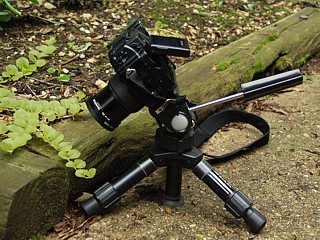
|

| |
|
Getting a close-up of some crawling plant in my patio. Note that the lens-to-subject distance is 5 cm or so, and the tilting LCD monitor comes very handy in such situations. |
...And here is the result. Aperture priority with -1.3 EV exposure compensation, F/8 at 1/13s, ISO 100. Image slightly re-equalized in Photo-Paint, reduced and re-sharpened. | |
|
The solid, -1.3 EV exposure compensation was used in this picture in order to deepen the color saturation, to get the background out, and to avoid burn-outs in the reflective leaf surfaces. The last issue could have also been helped by use of a polarizing filter, and one day I'm going to write a small article on that subject. Samples The samples, unless explicitly stated otherwise, show the full frame at the left, reduced in size and re-sharpened, while at the right are one-to-one fragments of original images, without any postprocessing. Here is a simple shot of my computer's screen, taken in the "Super Macro" mode. The whole field of view at the left is just 32 mm wide (the full frame has been reduced and re-sharpened), and the corresponding width of the 1:1 sample at the right is less than 4 mm. The front of the lens was just 24 mm away from the subject. (You can find the original image here.) | ||
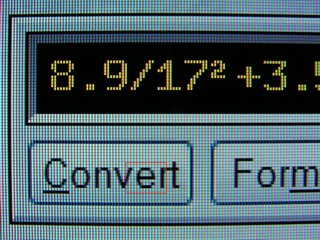
|
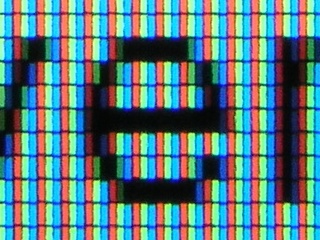
| |
|
EFL=59 mm, aperture priority with -0.3EV bias, 1/13s at F/5.6, ISO 100; sharpness at -2, contrast at -1, saturation at +1. | ||
|
Actually, you can clearly see the structure of the TFT screen, usually not discernible with the naked eye. You can also notice some degree of barrel distortion which I find typical for macro applications. To show you a more typical macro example, here is a picture using regular household lights in my living room. The dial is 18 mm across (and the camera shown is a 50-years old Exakta). | ||
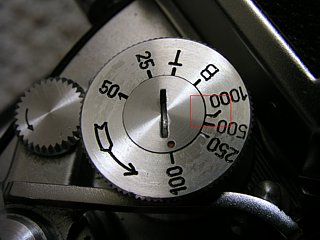
|
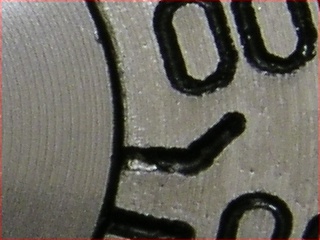
| |
| EFL=59 mm, aperture priority mode at +0.3EV, 2s at F/8, ISO 64, white balance by reference; image processing at "Normal". | ||
|
Now, try to take a shot like this using your film SLR camera. Note that the lens here was closed down to F/8; to achieve a similar depth of field on a 35-mm film you would have to use F/40! (See my article for more.) After having tried out the "super macro" capability in some other cameras, I was quite skeptical, not expecting any decent performance. Surprise — the 3-cm close-ups from the C-5050Z are more than respectable! If you search the Web, you may find some macro samples from the C-5050Z, which might lead to conclusions different than mine. You have to remember one thing here: 80% of the result depends on the photographer, and only 20% — on the camera. The pictures I have seen were badly focused, shot in the program mode at the widest aperture (with almost non-existent depth of field this is asking for a disaster), some of them handheld at exposures of 1/2s or so. No camera would do an acceptable job in these conditions. Let me show you what I consider an acceptable macro shot of the innards of a watch, at least for the purpose of evaluating the camera and its lens. Again, a reduced full frame at the left, "raw" 1:1 sample at the right. The picture was taken with a mini-tripod, and the light was provided by a nightstand fixture. | ||
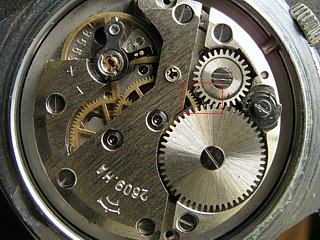
|
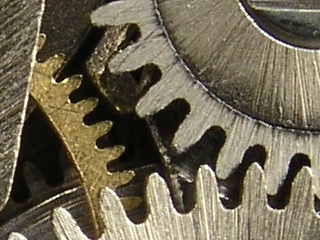
| |
|
EFL=59 mm ("super-macro"), aperture priority mode, +0.3EV, 1.3s at F/5.6, ISO 64, white balance by reference, all image processing at "Normal". | ||
|
By the way, the "reference white balance" feature in this camera seems to be working beautifully, better than in the E-20. This picture was taken at a 40W bulb in a paper lamp shade! The next sample has been shot on my patio in late afternoon sunlight, handheld. Again, the sample at the right is raw, i.e., without any postprocessing. (I went through a number of insect-shooting sessions with the '5050, and I must say I am quite impresed with how the autofocus works in the "super macro" mode. A few more examples can be found in my Critters galery.) | ||

|
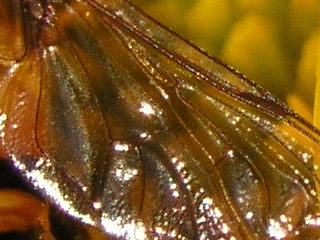
| |
|
EFL=59 mm ("super-macro"), aperture priority, 1/650s at F/5.6, ISO 100, auto white balance, no exposure compensation, contrast and sharpness at -2, saturation at +1, saved in the HQ mode. | ||
|
Yet another example: some flowers in my company's parking lot, shot handheld in a falling rain. The field of view is about 4 cm wide, with the shooting distance of about 5 cm. | ||
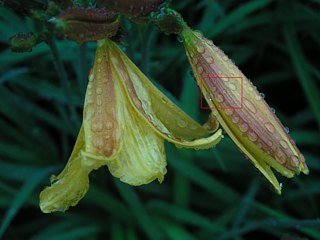
|
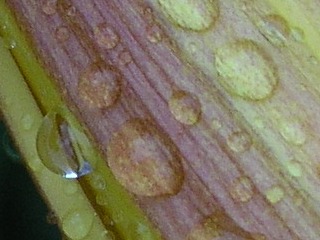
| |
|
EFL=59 mm ("super-macro"), program mode, -0.7EV, 1/125s at F/3.2, ISO 100, white balance at "sunny", contrast and sharpness at -2, saturation at +1, saved in the HQ mode. | ||
|
(As the day was heavily overcast, the contrast quite low and the color too cold, the image will gain quite a lot in postprocessing. An XGA version after a slight crop, some equalization, color balancing, and sharpening can be found here.) Adding things up This is the first time Olympus cameras allow for such close focusing ranges, and what a welcome change this is. (Note: the C-4000Z model also has this capability, but not the older '4040 or the 30x0 series.) Some other makers' models had that earlier (most notably, the Nikon 9xx and 4xxx series), but with varying image quality. This, however, is a first-class attempt. After decades of meddling with extension bellows, macro extenders, and close-up attachments on my film SLRs, I can finally shoot macro as I please, additionally aided by the great depth of field inherent to digital cameras. As great as my top-dog E-20 digital SLR is (especially the lens), after having bought the C-5050Z I find myself using the latter for macrophotography all the time, and I am very happy with both the ease of the process and the results. | ||

| My other pages related to the Olympus C-5050Z, C-5060WZ, and X-7070WZ |
|
Camedia® and Olympus® are registered trademarks of Olympus Corporation.
This page is not sponsored or endorsed by Olympus (or anyone else) and presents solely the views of the author. |
| Home: wrotniak.net | Search this site | Change font size |
| Posted 2003/05/24; last updated 2003/07/21 | Copyright © 2003 by J. Andrzej Wrotniak |